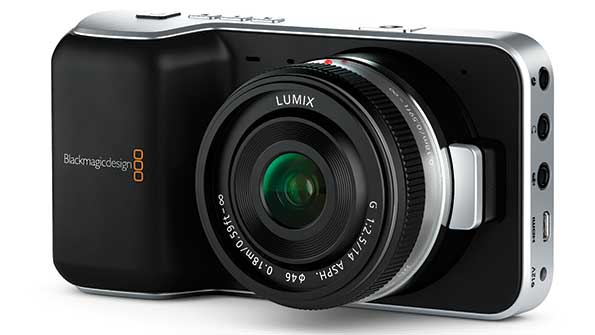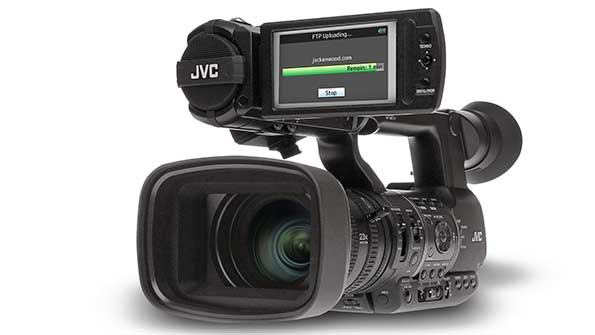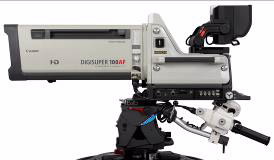A Personal Take on TV and Cinema Cameras at NAB
The camera market has opened up a lot since the days of choosing between Sony and Panasonic, or Grass Valley for studio cameras. The move to single sensor CMOS has opened the door to all manner of new entrants, from Blackmagic Design to GoPro. There is even Digital Bolex!
As a result of this opening out of the number of camera suppliers is that we are also seeing long-standing manufacturers of other video equipment entering the imaging market with specialist cameras, with FOR-A being a good example. There was considerable interest in FOR-A’s new FT-ONE 4K variable frame camera for sports coverage.
This camera was shown in operation at the 2013 NAB Show in tandem with the Evertz Dreamcatcher. Evertz has been trialing this slo-mo system at some major sporting events over the year. As well as slow-motion replay, Dreamcatcher allows for multiple angles to be synchronized and played out at a single-button press and can take advantage of 4K camera feeds. The operator can zoom in to the 4K raster to create an HD replay without the loss of detail that would be evident with an HD camera feed. Sports replay specialist, EVS, also integrates with the FT-ONE.
Although 4K to the home may be a few years off, such products have led to talk of 4K acquisition in sports as a way to enhance the production or to cut down on camera positions for minor league games. An HD image can be derived from a 4K camera covering a wide angle of a stadium by zooming into the region of interest in the game.
Post-processing
Sony was also showing advances with its stitcher, which was shown as a technology demonstration at IBC2011 with HD cameras. Three side-by-side HD cameras feeds are stitched to give a 6K x 1K view of the entire field of play. This has been in use with Sky Sports in the UK and Italy as well as Canal+ in France. Sony has also worked with the NBA and NFL. The system has been used for analysis of replay in conjunction with the Sony telestrator (this uses tracking data from third party products like STATS SportVU player tracking. The general feedback is that directors want a greater zoom magnification. At NAB, Sony showed two 4K, 60P cameras stitched to an 8K x 2K image, allowing more freedom in zooming. The roll-out of this technology awaits the launch of 4K cameras with live outputs. (Cameras like F65 shoot files to memory.)
Powerful image processors like AJA’s OEM product Corvid Ultra also support such arbitrary scaling with its TruScale technology.
The professional video industry's #1 source for news, trends and product and tech information. Sign up below.
Another player tracking system is ChyronHego’s TRACAB. This uses image processing technology to capture all movements in a sports arena in real-time. The application creates a data feed with the X, Y and Z coordinates of objects in the scene. The data can be typically used by graphics applications to enhance the viewer experience.
Low light capture
FOR-A is also marketing an ultra high sensitivity HD camera, the FZ-B1 from partner Flovel. This can produce color images at 0.005 lux, and is attracting interest from nature shooters and stargazers. Conventional low light cameras have used image intensifiers of infrared, both creating a monochrome picture. In contrast, the FZ-B1 uses a very sensitive CMOS imager with a color filter array.
Blackmagic Design
For the more filmic shooter with modest budgets, Blackmagic Design again surprised everyone by expanding its product line with two new cameras to complement the 2.5K Cinema Camera. NAB saw the launch of the Pocket Camera and Production Camera 4K. The pocket camera has a super-16 sized sensor and takes MFT lens in a remarkably compact body. What sets it apart is the raw capture, allowing for later grading. It provides a great entry-level for the indie filmmaker. Twenty years ago, this group had to be very frugal with precious stock and pay lab costs. Now has never been a better time to enter the budget filmmaking sector.

The Production Camera has a similar enclosure to the Cinema Camera but has a super 35mm size sensor. Interestingly the sensor has a global shutter, so no more jello effects. The 4K camera comes with a 6G-SDI live output. Used with the 4K ATEM switcher, it ready to go for the presentation and live event market using 4K large displays.
JVC
JVC is storming ahead with its ENG cameras, available at fraction of the price broadcasters once had to spend on a newsgathering camera. One broadcaster told me that for him, the days of the $35k camera were over. For the manufacturer, they can hope that quantity can make up for the lower prices of today’s cameras. Once example is the BBC purchase for 550 of the GY-HM650 for ENG applications to be delivered during 2013.

Version 2 of the camera has some neat features: two encoders to create a broadcast rez file plus a low rez to send back breaking news; AS-10 files for long GOP MPEG-2 encoding; and built-in Wi-Fi, 3G and 4G connectivity. The IP connections can be used to FTP camera files back to base or for remote control of the camera. All the functions on the flip-out viewfinder can be controlled from back at base. Your rookie VJ can’t white balance? No problem; set it up from base!
Canon
Canon featured its flagship EOS C500 Cinema Camera. Available in both PL and EF mount versions, the camera deploys a Canon-developed Super 35mm 4K CMOS iamge sensor to originate a choice of HD, 2K or 4K RAW files. The HD and 2K production formats output as uncompressed 12-bit RGB 4:4:4 video components. Uncompressed 4K RAW files can be selected to conform to the standardized UHDTV or cinematography production formats.
The EOS C500 delivers RAW HD/2K/4K file formats via a SMPTE standardized 3G-SDI serial interface, facilitating streamlined systemization with other equipment that conforms to this standard.
RED Digital Cinema
RED Digital Cinema introduced Red Dragon, the 6K sensor for RED EPIC cameras. The sensor captures 6K x 3K at 60fps with a claimed dynamic range over 16 stops. S/N is claimed to be 80dB — I remember when cameras struggled to reach 55dB.
The sensor translates to 9X more resolution than HD and over 19 megapixels. RED EPIC and SCARLET owners will be able to upgrade their existing sensors to Red Dragon.
The company also highlighted the RED ONE. Using an S35mm image plane, the RED ONE displays a natural depth of field from 2K to 4.5K resolutions. In addition, the SCARLET-X allows users to simultaneously capture 4K video and stills on the spot. Users can record 4K REDCODE raw at up to 30fps and capture every moment.
ARRI
ARRI showcased its ALEXA digital camera systems with the XT refresh. The updates include internal ND filters and an XR memory module developed with Codex, which allows ARRIRAR to be captured to 512GB drives. The cameras all have the same high-end optical low-pass filter, a custom-made CMOS sensor, and custom electronics and processing software. The sensor provides an exposure latitute of 14 stops with special consideration given to highlight treatment. The cameras feature high sensitivity and hold up well even when extremely under- or overexposed, making them easy to work with.
Interestingly, the updates to Alexa do not extend to a 4K sensor. Arri users like the organic 'filmic' look of the sensor, finding it more like film than the super-sharp 4K look. With so many DPs opting to shoot with Alexa, maybe resolution isn't everything!
Grass Valley
Grass Valley are trying something radical in the camera world, although it is common is post production software. Features are licensed, and enabled in the software. The LDX series of cameras have a common hardware platform, but the functionality can be changed to a higher level model via a GV-eLicense. How you upgrade is up to you—permanently or temporarily (7 days); one, two, or three levels up, so a bradcaster can licence the top of the range just for a special program, saving on the additional CAPEX to purchase the features that aren't used day-to-day.
Hitachi

Hitachi introduced their latest HD studio and OB camera, the SK-HD1200. Based on 3 X 1080P CCD sensors, the camera has 3Gb/s fiber output that can use optical routing to connect several heads to the CCUs to simplify camera interconnections.
Panasonic
Panasonic introduced its third-generation VariCam HD production camera, which improves upon the camera's signature features — such as off-speed shooting and film-like image production — while incorporating the company's new AVC-ULTRA family of video codecs.
The VariCam uses three advanced, full 1920 x 1080p wide dynamic range MOS images for native 1080/60p recording/operation. It also features a true RGB imager/prism system that provides full resolution color.
Summary
Cameras are getting more sensitive — it is now feasible to use candles as key lights — dynamic range has improved, and frame rates of 120fps are no longer the preserve of specialist sports cameras. But all this increase in performance has come with a decrease in price. Isn't technology great?!
Minor revisions 4/22/13.
